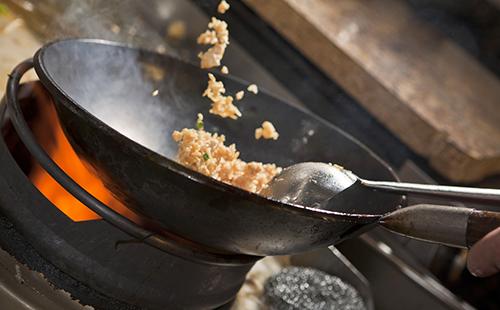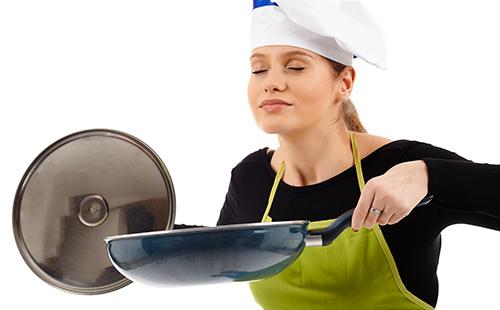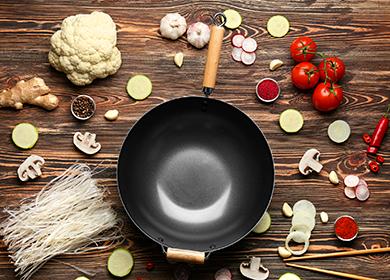The content of the article
What is the difference between a wok pan and a regular pan? A wok is a versatile kitchen assistant that can easily replace numerous pots, pans, stewers and even grills. The structural features of this vessel allow you to implement almost all the ideas of the cook. And various modifications of the wok bowls made this Asian pan indispensable in the modern kitchen.
Meet this - voka
Wok, which is translated from Chinese as “frying pan”, has more than 2,000-year history. In ancient times, Chinese peasants had the opportunity to use exclusively dry grass and straw for burning a fire, which burned out instantly and did not give enough heat. A thin-walled conical bowl with a convex bottom hanging directly above the fire, made it possible to achieve the readiness of the dish in a matter of minutes.
Today in its original form a frying pan woks with handles and a convex bottom, everything is also popular in their homeland and in countries where there are many connoisseurs of traditional Chinese cuisine.
However, for widespread use, modern woks are available with an already flat bottom for the possibility of using a frying pan in modern kitchens on stoves of various types, be it:
- electric stove;
- induction cooker;
- gas oven;
- a plate with a glass-ceramic coating.
Wok pan as in the photo: why you need 4 advantages of the product
The adaptation of an old frying pan from China to modern life deprived the wok of its main characteristic - maximum bottom heating for lightning fast cooking. But on the other hand, current stoves are not heated with straw, and the bottom diameter has remained minimal, so that basically the main advantages of the bowl still remain. Four main ones can be distinguished.
- Heat treatment speed. The principle of operation of this pan is to quickly fry food at high temperature. And modern woks cope with this no worse than authentic ones.
- Cooking versatility. In addition to roasting, wok, depending on the configuration, can be used for almost any cooking method. The lid significantly increases the functionality of the pan, because with it both stewing and cooking became available. If the grid is also complete with a pan, then it can be used to filter out excess oil from the tank, or products that are deep-fried are laid out on it to make glass butter. And also with the grill you can cook healthy food for a couple.
- Food quality. Since dishes are cooked in very hot oil very quickly in a wok, this allows you to save as much as possible all that is useful in the products. In addition, a delicious crust with crunch in such a roasting pan is definitely guaranteed.
- The convenience of use. The design feature of the wok pan allows you to quickly and conveniently cook food.Due to the high sides with the active mixing of the prepared pieces, you can not worry that they will scatter outside the container. Strong riveted handles allow you to move and hold the pan. And new models of woks with removable handles also make it possible to compactly store kitchen gadgets.

Varieties and cost
Before choosing a wok pan, you need to study its features, characteristics and criteria that affect the quality and functionality of a traditional Chinese dish.
Which metal is better
Each metal has its own advantages and disadvantages. And it is precisely the characteristics of the material that ultimately determine the pros and cons of the wok pan. What are woks made from?
- Aluminum. Very light and quickly warms up. However, such pans are very unreliable in terms of safety, and they can only be used on gas and electric stoves.
- Carbon steel. The wok from this material will be relatively light, affordable, fairly strong and durable. With proper care, food in such a pan will not burn. But rust and deformation over time can easily comprehend this kitchen appliance.
- Cast iron. Durable in heating, but resistant to rapid cooling, the cast iron wok is quite weighty and fragile. If you choose a thin wok with walls of 3 mm, then you should be prepared for the fact that such a pan can burst at any time. Thick-walled nine-millimeter woks are very massive, but stronger. The advantages also include the non-stick qualities of cast iron. But the fat minus can not be hidden anywhere - cast iron is prone to rust.
- Stainless steel. Professional speed wok is made of one-piece steel sheet. Iron-carbon alloy with the addition of nickel and chromium is most practical for kitchen applications. This metal does not rust, it is durable, and can withstand high temperatures, including open flame and severe frost. It is not deformed. With proper processing, food in this pan will never burn, will retain all its usefulness and goodies. In addition, this pan can be used on trendy induction cookers. In such devices, induced eddy currents created by a high-frequency magnetic field provide heating.
Coverage Matters
Modern manufacturers of dishes use different types of coatings for their products. Such a newfangled trend and wok pans did not pass.
- Granite. A reliable and durable layer has all the positive qualities of cast iron, which are also supported by excellent thermal conductivity. Food in such a pan cooks many times faster. In addition, such kitchen appliances are quite light and comfortable to use.
- Teflon. The most popular type of coating, which has high non-stick properties. This material is resistant to the aggressive effects of acids, alkalis and moderate temperatures. However, the use of a wok pan with non-stick coating requires special working conditions, as well as the availability of special plastic or wooden appliances for mixing. Otherwise, scratches will appear on the delicate coating of the pan, and such dishes will quickly become worthless. In addition, the Teflon coating under the influence of high temperatures, which are just what is required for cooking in a wok, can be destroyed, and if the protective layer of the pan is damaged, harmful toxins begin to exude.
- Titanium. Environmentally friendly non-stick coating, which certainly does not emit any harmful effects and has incredible resistance to mechanical stress. Safety and more than 25 years of service with dignity cover the additional costs of such a wok.
- Ceramics. This coating is much stronger than Teflon. It provides an even distribution of heat on the surface of the pan and its long retention. Such a pan does not negatively affect the taste of cooked food. Ceramics do not require any special care.In contact with her, you can use metal spatulas and spoons, she is not afraid of mechanical damage and detergents. But from a sharp temperature drop, the ceramic coating may well crack.
- Enamel. Over the long term of existence, this type of coating of the pan has proved to be an excellent protection against metal oxidation. But the instability to shock, mechanical stress and temperature changes makes enameled woks unreliable.
Wok prices vary and depend on the size and thickness of the pan, material and manufacturer. For example, an Italian aluminum wok with a diameter of 28 cm, covered with a layer of ceramics, costs about 3,500 rubles. An aluminum pan with the same diameter and Teflon coating, produced in Vietnam, costs 2,320 rubles. A purely aluminum wok of Ukrainian production, the diameter of which is 26 cm, can be bought for 630 rubles. Steel German wok, with a diameter of 21 cm, will cost 1750 rubles. (Prices are current in July 2017).
How to cook in a wok and where it is applied
What is cooked in a pan vogue only Chinese dishes are a big mistake. And since gourmets have their own taste preferences and peculiarities of preparing national dishes in different parts of the world, modern woks began to be produced internationally:
- European
- Chinese
- Asian
- western.
Some pans are deeper, others are thicker, and the diameter of the bowl may vary. One thing remains unchanged - the technique of cooking in a wok. Consider three rules.
- Cut the food into small pieces.
- Add them sequentially, starting with those that take longer to fry.
- Stir the ingredients constantly to speed cooking.
2 recipes for your note
Chinese dishes are plentifully smeared with ginger, onions and garlic, and are cooked preferably over an open wood fire. Such food turns out to be very rich, tasty and “with smoke”. If you use a wok pan, you can achieve the same result in modern kitchens. Try two recipes.
Funchoza with Teriyaki sauce
Ingredients:
- funchose vermicelli - 200 g;
- chicken fillet - 300 g (can be replaced with beef);
- Teriyaki sauce - ½ cup;
- bell pepper - one fruit;
- onion head - one piece;
- carrots - one root crop;
- fresh ginger root - 10-20 g;
- parsley fresh herbs - one bunch;
- oregano - 1 g;
- sesame seeds - two to three teaspoons;
- flavourless sunflower oil - one pile;
- garlic - three cloves.
Cooking process
- Funchoza pour boiling water, insist for three minutes and lay on a sieve.
- Fry sesame seeds in a dry pan.
- Wash all vegetables and roots, peel and cut into thin strips.
- Meat also needs to be cut into oblong pieces - cubes.
- Pour oil (50 ml) into a wok-frying pan over high heat and add meat. You need to cook the chicken for five minutes, constantly stirring.
- Five minutes later, add garlic and ginger to the wok.
- After another two minutes - carrots, onions and peppers.
- When the vegetables are soft, add finely chopped parsley, oregano and teriyaki sauce to them.
- After one or two minutes put the funchose and sesame seeds in the wok, mix everything and turn off the heat.
Ham and Mushroom Risotto
Ingredients:
- ham - 200 g;
- fresh champignons - 200 g;
- basmati rice - one glass;
- water - one and a half glasses;
- salt and spices to taste;
- hard cheese - 100 g.
Cooking process
- Cut the cheese and ham into strips and fry the wok for three to four minutes in a hot frying pan.
- Pour washed basmati rice into the container and pour water.
- Add salt and spices.
- Stew the dish under the lid for half an hour.
- Sprinkle the finished risotto with grated cheese.
Wok in the kitchen: where to start
And after long evaluations, you have chosen and bought a new steel wok.And I can’t wait to start cooking delicious dishes. However, before you start using the wok pan, you need to prepare it properly. And if everything is done correctly, then the food will be obtained beyond all praise, nothing will ever burn and stick. And the pan itself, with proper care, will serve a long faithful service. Before the first use, carry out preparatory treatment. The procedure involves six sequential steps.
- Remove dust. To start, the pan should be wiped with a dry paper towel to remove dust and excess industrial grease.
- Ignite. Next, put the dish on a large fire and dry calcine it until black. You need to calcine the entire surface of the pan, so turn the sides of the container so that the fire falls on them.
- Add water. As soon as the pan becomes completely (both outside and inside) black, pour two or three parts of water into it and quite a bit of dishwashing liquid.
- To clean. Using an iron washcloth, without pressure, clean the inside of the pan and rinse under running water.
- Oil. Having wiped dry the washed and calcined wok, put it again on the fire and pour 50 ml of vegetable oil. As soon as the oil warms up, apply it with a silicone brush to the inner walls of the pan. We warm the butter wok for another ten minutes and drain the oil.
- Wipe dry. Dry with a soft cloth and wipe the pan inside and out, leaving an even, thin oil coating. It is this coating that will serve as an additional non-stick coating and will also protect a valuable gadget from external negative influences.
In the kitchen, the hostess can find many appliances and items that make it possible to cook dishes of varying complexity. The wok will be a worthy instance in the cook's collection and an indispensable assistant. But if you doubt the need for this gadget, then the final decision will help to take feedback on the wok pan.

Reviews: “The dish is ready in 3, not 30 minutes”
After viewing various options, the wok chose a cast iron with a non-heating handle. I do not know what the owners of pans with two ears have to do there, but in my opinion it is much more convenient to take the pan by the handle and wash it after frying.
The main idea of the purchase is to fry potatoes in it for the husband. He said that he had never eaten so tasty before (cut into cubes). My favorite dish is carrots, sliced in circles and dark bread, diced. I fry it for a couple of minutes and combine it with a hand-made liver pate.
The overall impression is to prepare so fast that at first there is a feeling of extra time - cut, abandoned and ready, in 3 and not in 30 minutes.
Complex dishes of Chinese cuisine have not yet come up. Yes, and why? Management mastered for personal tastes no more than slicing meat, potatoes, carrots and onions in soy sauce. He ate - and as if again in Asia. Another such nuance: before starting work, you need to fry it with salt several times - the grease is removed.a guest, http://forum.awd.ru/viewtopic.php?f=380&t=121405
I fry the potatoes and vegetables in general in this pan. It is possible and meat, if sliced. I really like. I think that such a pan is simply necessary on the farm. About the bulky: you can choose the right size, they are different. I'm not bulky at all, very comfortable.
Arabesque, http://forum.cofe.ru/showthread.php?t=103700
Take a thick-walled one, it’s better to cook in it, the dish comes out when the fire is off .. and choose a diameter, the Schaub on the stove went in exactly, for comfort in the sense of ... that is, not the size of a basin. Well, the glass lid helps out a lot, you don’t need to open it again .. Look at the handles so that they are riveted either on bolts, but not on spot welding, they will fall off .. and preferably 2 handles ... long and short ...
ANDREY1975, http://www.yaplakal.com/forum14/topic898774.html
I bought, after all, a wok. For 2000 rubles. Steel. Happy as a boa constrictor! WHAT in it tender meat is obtained ....MMMMMM .......
NathalieV, http://forum.materinstvo.ru/index. php? showtopic = 432882

